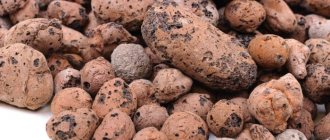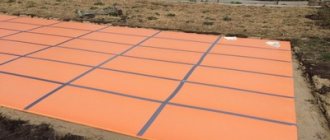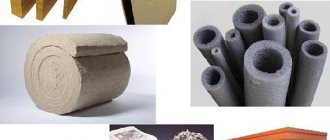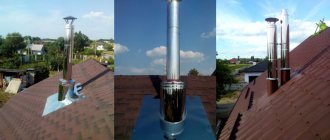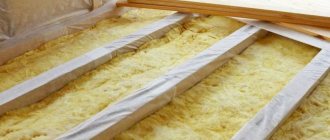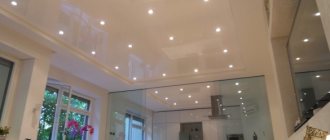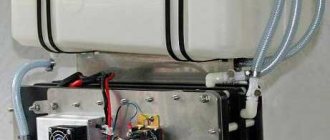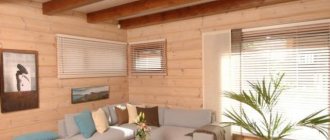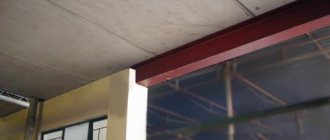Vermiculite insulation features and application
Composition and processing of vermiculite
Vermiculite contains several components connected by one chemical formula. It contains the most silicon - about 35%; there is also 10% magnesium, iron, potassium, calcium, etc.
Natural vermiculite comes in the form of large, scaly crystals. When exposed to high temperature, they are transformed into winding twisted threads-columns, increasing in volume up to 10 times.
When the material is heated above 1000 degrees, expanded vermiculite is obtained - a light bulk material, brownish, golden in color.
Hygroscopicity
The main distinguishing feature of expanded vermiculite (hereinafter simply vermiculite) is its high hygroscopicity. 100 grams of material can absorb up to 500 ml of water. But vermiculite dissolves just as easily with water.
In fact, it is a natural hydraulic accumulator. Therefore, it is mainly used in crop production, as a soil additive.
Thermal insulation
Another feature of the material is its high thermal insulation qualities. The thermal conductivity coefficient of bulk vermiculite is in the range of 0.05 – 0.07 W/ (m*K) depending on the size of the fractions and compaction density. This makes it possible to use the material as an effective insulation material.
1 mm, 120 kg/m3 – 0.059
2 mm, 110 kg/m3 – 0.057
4 mm, 95 kg/m3 - 0.054
8 mm, 65 kg/m3 – 0.052
The use of vermiculite as insulation
It is effective to use vermiculite as bulk insulation for thermal insulation of floors and ceilings. And also for filling various cavities in walls, partitions, pipeline ducts....
When used on attic floors, reliable waterproofing on the roof side is required, as well as covering the material layer with a vapor-permeable membrane (paper layer). On the side of the room, there should be a vapor barrier film under the material
During installation, special attention is paid to ensuring continuity
Special Use
Rigid slabs are made from vermiculite. They are more expensive, but can be used instead of mineral wool, as they have similar characteristics to it.
On the physico-chemical properties of expanded vermiculite.
Expanded vermiculite is a loose porous material in the form of scaly particles of silver, golden or yellow color, obtained by accelerated firing of vermiculite concentrate - hydromica containing bound water between the elementary layers. Swelling occurs as a result of the splitting of vermiculite particles under the influence of water vigorously evaporating from them into very thin scales, which only retain adhesion to each other at certain points.
Expanded vermiculite has a peculiar lamellar porosity, which determines the volumetric weight of 100–300 kg/m3 and thermal conductivity of 0.065–0.09 kcal/m/hour deg and, at the same time, the elasticity of the grains, due to which it does not settle in heat-insulating backfill structures.
The chemical composition of vermiculite corresponds to the approximate formula (Mg+2, Fe+2, Fe+3)3 [(AlSi)4O10]·(OH)2·4H2O.
| The chemical composition of vermiculite corresponds to the approximate formula (Mg+2, Fe+2, Fe+3)3 [(AlSi)4O10]·(OH)2·4H2O | |||
| SiO2 | 38,0 – 49,0 % | TiO2 | 1,5 % |
| MgO | 20,0 – 23,5 % | Cr2O3 | 0 — 0,5% |
| Al2O3 | 12,0 – 17,5 % | MnO | 0,1 – 0,3 % |
| Fe2O3 | 5,4 – 9,3 % | Cl | 0 – 0,5 % |
| FeO | 0 – 1,2 % | CO2 | 0 – 0,6 % |
| K2O | 5,2 – 7,9 % | S | 0 – 0,2 % |
| Na2O | 0 – 0,8 % | H2O | 5,2 – 11,5 % |
| CaO | 0,7 – 1,5 % | ||
However, vermiculite rarely meets the general formula and usually contains impurities.
Physical properties: — hardness on a mineralogical scale: 1—1.5; - density: 2.4-2.7 g/cm3 (expanded - 0.065-0.130 g/cm3); — melting point: 1350 °C; — application temperature: from −260 °C to +1200 °C; — pH value: about 7.0; — thermal conductivity: 0.05 W/m.K (depending on specific gravity); - does not lend itself to abrasion and has lubricating properties similar to graphite.
The main and most valuable property of vermiculite is its ability, when heated, to sharply and unusually increase its volume by 10-20 times. This phenomenon is explained by the fact that during calcination, molecular water in vermiculite flakes and packs turns into steam, under the pressure of which the mica leaves always move apart in one direction, perpendicular to the mica cleavage. Vermiculite expanded in this way, when cooled, retains its acquired volume with the thinnest gaskets of air instead of water vapor between the mica leaves, which gives the mineral many of its valuable properties.
Nomenclature
Expanded vermiculite is produced in accordance with TU 5712-091-00281915-2007 and is divided into grades depending on the volumetric bulk density and grain size of the main fraction.
VVF means Expanded Fractionated Vermiculite. Grade 100 means that the volumetric bulk density of vermiculite is no more than 100 kg/m³.
St. Petersburg Mica Factory offers expanded vermiculite:
Most thermal insulators have one or more flaws - they are either fire hazardous, expensive, or not environmentally friendly. In search of the optimal option, developers are often interested in the idea of using vermiculite in this role - a layered mineral that, at high temperatures, changes its structure and acquires new properties, which at first glance are quite suitable for insulating a building. How versatile is this insulation, does it have any disadvantages, and how to use it correctly?
Properties of expanded clay
- high strength
- fire resistant
- frost-resistant
- does not contain harmful impurities;
- does not absorb water;
- durable
- does not lose its properties and is not destroyed when frozen
- not subject to rotting
Absolutely safe for humans and the environment.
Expanded clay is a product of rapid firing of low-melting clays. From Greek, the word “expanded clay” is translated as “burnt clay,” which is absolutely true. Despite heat treatment, it not only does not lose the properties inherent in the clay itself, but also acquires additional ones, becoming porous.
Photo: Properties of expanded clay material. Application area
On their basis, expanded clay concrete blocks are made, the thermal insulation and mechanical properties of which allow them to be used for the thermal insulation construction of floors, walls, ceilings, foundations and basements. Thanks to the expanded clay filler, these blocks also acquire its properties. They are lightweight, durable, fireproof, acid resistant, etc.
Insulation with vermiculite
The most common method of insulation is the backfill method. Many parts of buildings are insulated with granular filler:
- pitched roofs;
- attic floors;
- walls;
- floor.
Thermal insulation of pitched roofs
The thickness of the layer used for thermal insulation of the roof depends on climatic conditions and is in the range of 10–20 cm. The work is carried out in the following sequence:
- a vapor barrier film is laid on the rafters;
- a sheathing is mounted on the vapor barrier;
- the sheathing is covered with a layer of waterproofing, which is fixed with a construction stapler;
- loose insulation is poured into the resulting space;
- roofing material is laid on top and secured.
The inside of the roof is lined with plywood, decorative panels, clapboard, etc.
Insulation of attic floors and floors
Insulation of the floor and attic is carried out using the same technology.
The vapor barrier film is overlapped on the ceiling and placed on the joists. Adjacent rows should overlap each other by at least 10 cm. All seams are sealed with adhesive tape.
The insulator layer is backfilled and leveled to a thickness of 10–15 cm. Then a second layer of vapor barrier is installed. Such thermal insulation is not afraid of rodents and is not susceptible to fungus and mold.
The edges of the diaper should be folded up and glued. On top of it you can lay two layers of plywood 10 mm thick. The sheets should be joined closely, leaving a gap near the walls. The second layer should be laid in such a way that the middle of the sheet coincides with the seam of the bottom row.
Warm walls
The insulator is backfilled during the construction stage. Walls with bulk material are a multilayer system, including a load-bearing base, a facing layer and insulation.
Laying is done in such a way that a space is created between the cladding and the load-bearing wall for filling the filler. To prevent shrinkage of the bulk substance, it is compacted during construction.
Work is performed in a certain sequence. The first stage is the construction of a load-bearing wall and installation of cladding: they should be carried out simultaneously to a height of 3–5 rows. The number of rows is determined by the height of the blocks used. Then vermiculite is backfilled, the insulation is compacted in height by 10–15%. Further work continues in the same sequence until the required height is obtained.
Walls filled with bulk insulation can “breathe,” which eliminates the formation of condensation. To increase thermal insulation performance, the wall surface can be plastered with warm mixtures based on vermiculite.
Areas of application
Discovered relatively recently, the mineral vermiculite and its derivatives have found many different applications today:
- Ecology, oil and chemical industries. Few people can answer when asked about vermiculite that it is an excellent sorbent capable of binding alkalis and acids. This property allows it to be used to neutralize a variety of chemicals in industries, as well as to limit oil spills.
- Nuclear industry and energy. It is used as an absorber of radioactive elements such as cobalt-58, strontium-90 and cesium-137, and also as a reflector of gamma radiation.
- Automotive and aviation industry. A variety of sound-absorbing and heat-insulating materials and products are made from vermiculite.
- In industrial and civil construction vermiculite is used as follows:
insulation, as well as sound and heat insulators for roofs and floors;
- for backfilling as insulating material into hollow panels;
- as a component of various plasters, lightweight concrete and dry building mixtures;
- in the manufacture of concrete and cement blocks, as well as heat-insulating mastics as a filler;
- in the production of fire-resistant and heat-resistant slabs, panels and other wall materials;
- when installing self-leveling floors.
5. In industrial and private plant growing and horticulture. Let's take a closer look at how vermiculite is used for plants.
Application of vermiculite
Vermiculite insulation can be used in a variety of forms:
- As a backfill insulation in frame structures and well masonry. In this case, waterproofing is not required.
- In insulating backfills for floors, roofs and attics.
- In warm masonry mortars during the construction of walls made of cellular concrete blocks.
- In plaster mortars - for additional insulation and sound insulation of external and internal walls and partitions.
- Vermiculite-based slabs and plasters for fire protection of load-bearing and enclosing metal structures.
- In floor screeds.
- As a filler for decorative plasters.
- In agriculture - to improve soil structure, mulch plantings and fertilize.
Technologies for laying vermiculite building materials
Work with mineral insulation is not difficult or harmful - in terms of the degree of impact on the human body, vermiculite coating, according to GOST 12.1.007-76, belongs to class IV (low-hazard substances). To prevent dust from getting into the eyes and respiratory system, before using vermiculite, the worker should protect them with goggles and a respirator. Provided the building material is stored in dry, indoor areas, its shelf life is unlimited.
Thermal insulation of house enclosing structures with backfill vermiculite
To protect the attic ceiling and the surface of the pitched roof from heat leaks, you need to follow a simple algorithm:
- Cover the inner lining with an overlapping vapor-proof film, which will prevent moisture from entering the vermiculite from the inside.
- Pour dry vermiculite into the resulting cavities in the roof frame.
- Lay a windproof super-diffusion membrane on top of it, the purpose of which is to prevent the material from weathering and at the same time allow vapors to circulate freely.
- Install the counter-lattice and lay the roof covering.
The insulation scheme for attic floors is, in principle, similar:
- Reliable waterproofing is laid on the lining between the beams.
- A log system is installed in a layer of 100–150 mm.
- Bulk insulation for the floor is introduced, which must be immediately covered with a vapor-permeable film.
- After installing the plank or plywood covering, the floor is ready for finishing.
- To reduce the cost of the material, vermiculite can be mixed with sawdust in a ratio of 1:1 or 3:2.
Model of insulation of frame wooden walls
Filling the walls with vermiculite is possible at the stage of their construction using frame or well technology or during the process of external insulation. To do this, as the load-bearing wall and facing layer are erected, the space between them is filled with vermiculite granules with light tamping. The approximate layer thickness is 100 mm (for Moscow). Additional vapor and waterproofing is not required, ventilation gaps in the external wall are also not needed.
Another way to create an insulated wall is to fill the cavities of building blocks with vermiculite. The thermal insulation effect of such a design increases sharply, and the free exchange of vapor in the wall is not disturbed, and it remains light and breathable. If necessary, the outer wall can be further insulated if it is built from concrete panels based on quick-hardening cement with the addition of loose wall insulation.
Proportions of solutions for screeds
Insulation with dry vermiculite is a rather expensive solution, so in private construction they prefer to add this material to construction and finishing mixtures. To prepare a solution for a thermally insulated screed, you need to stock up on standard M400 Portland cement, sand and fine- or medium-fraction vermiculite. Due to its high water absorption, the solution must be used within 30 minutes after mixing.
For reliable insulation of the floor above an unheated space, 100 mm of screed is usually sufficient, and for interfloor ceilings, 30 mm is sufficient. It must be remembered that the poured floor, due to the small mass fraction of cement, is not frost-resistant, therefore such screeds are recommended only for heated rooms.
Recipe for plaster mortars for exterior use
To plaster the walls from the inside, you can use the same composition, but for their external treatment, the proportions of the solution must be slightly changed. Both external and internal plasters have high vapor permeability, facilitating normal self-regulation of the internal microclimate. Warm plasters based on vermiculite have a natural golden or silver tint, but if desired, pigment of the desired shade can be added to their composition.
Plaster for interior decoration: C – cement, I – lime, G – clay, V – vermiculite
When laying walls, it is advisable to use modern thermal insulation materials (gas, foam blocks, vermiculite concrete), and the seams between them should be made of masonry mortar with a low thermal conductivity coefficient. You can knead it using the same vermiculite, having previously decided on the optimal composition.
Thus, the demand for vermiculite in construction is obvious: excellent manufacturability and a unique combination of properties bring vermiculite backfills and slabs to the forefront among fire-resistant insulation materials. The only significant obstacle to expanding the scope of their application is the high price, but increased production gives hope that this will soon be eliminated.
Specifications
The parameters of vermiculite depend on the size of the fraction; in addition, its exact composition has an impact. Key characteristics of expanded vermiculite:
- thermal conductivity;
- hygroscopicity;
- sound absorption;
- heat resistance.
Fractions smaller than 4 mm are mainly used in construction. The coarse fraction is used as a filler for refractory concrete. The fine fraction of 0.5-1 mm is used as a bulk heat insulator, which is used to fill voids in walls or as a fill for insulating floors. The characteristics are presented in the table.
| Thermal conductivity, W/m*K | Density, kg/m3 | Moisture content, % | Sound absorption coefficient at a frequency of 1 kHz | |
| Vermiculite expanded 0.5 mm | 0,053 | 144 | 3 | 0,56-0,6 |
| -//- 1 mm | 0,050 | 125 | 4 | 0,6-0,65 |
| -//- 2 mm | 0,049 | 100 | 4 | 0,7-0,8 |
| -//- 4 mm | 0,048 | 94 | 5 | 0,7-0,8 |
| -//- 8 mm | 0,045 | 87 | 3 | 0,7-0,8 |
More details on properties.
Thermal conductivity. The layered structure of the material after swelling under the influence of temperature has a dominant role on this parameter. The individual plates remain firmly connected, but the direct contact between them is broken and filled with air. The material itself has a thermal conductivity of the order of 2-2.7 W/m*K; due to the breaking of bonds between the crystalline plates, this figure is reduced to 0.03-0.12 W/m*K, which puts it on a par with mineral cotton wool and extruded polystyrene foam. At the same time, it is used in bulk, from which the material is able to fill all the irregularities and niches.
Hygroscopicity. A property that explains the demand for vermiculite in agriculture and even hydroponics. The gaps between the crystallized plates are filled with equal ease by air and water. The material is highly hygroscopic. For example, 100 grams of vermiculite can hold up to 500 ml of water. More importantly, water and moisture enter and exit the material with equal ease. When using vermiculite as insulation for building envelopes, this must be taken into account and it is advisable to use it as an advantage, and not as a disadvantage.
Sound absorption. Vermiculite has proven to be an excellent material for creating soundproof barriers. High absorption, lack of settling in the material during compression and increased elasticity allow reverberation to be controlled over a wide range. Simply put, vermiculite is able to absorb sound waves without producing secondary waves or extraneous sounds under the influence of friction or deformation. When vermiculite is compressed and pressed by approximately 10-20%, maximum absorption of sound waves is achieved.
Heat resistance. The melting point of vermiculite exceeds 1300 degrees. After swelling, the material no longer undergoes modifications and is not subject to decomposition, changes in composition, etc. This makes it a heat-resistant material that can be used to insulate stoves, fireplaces, pipes and chimneys.
Vermiculite boards
In addition to these characteristics, vermiculite can be described by a number of useful properties:
- Environmentally friendly, without harmful emissions in the entire range of permissible operating conditions.
- Prevents condensation. It quickly absorbs moisture, and then just as easily releases it in the form of steam. It is important to create optimal conditions for removing excess moisture.
- High turnover. Easily fills voids, niches and surfaces of complex shapes.
- Does not attract rodents. It is not an attractive food for them and, due to its high hygroscopicity, quickly absorbs the odors of rodent marks, which makes them quickly lose interest in the space filled with vermiculite.
- Does not cause allergies.
- It is not radioactive and reflects part of the radiation spectrum, has a neutral pH.
Expanded vermiculite is sold as insulation in bags of 50 liters. This is enough so that with a layer thickness of 10 cm, two bags are enough to fill 1 m2.
Material with a fraction of 0.5-1 mm for insulating floors is supplied to the installation site via air ducts, just like, for example, ecowool. Otherwise, it is filled directly from the bags. There is no need for additional fluffing for filling.
Properties of vermiculite insulation
Vermiculite insulation is a material that is widely used in construction and finishing work during the construction of new buildings, and carrying out major and ongoing repairs of old buildings. It is used in the form of pressed slabs, as a filler and as an additive to plaster mixtures. It is used for insulating walls, floors, attics and ceilings. Insulation with vermiculite is carried out during the construction of pipeline systems and highways for various purposes, which significantly extends their service life. This has a positive effect on the operation of equipment and pipeline fittings installed for the smooth functioning of the entire system.
Technological features
Vermiculite in the form of slabs and in bulk.
Vermiculite is an environmentally friendly material created by nature. Belongs to the minerals of the hydromica group. It has a crystalline form of golden brown, yellowish or bronze color. It was found that when vermiculite plates are heated, they transform into threads or worm-like columns. Actually, this property made it possible to give the material such a name, because vermiculite means worm in Latin. After examining its physicochemical properties obtained after heating, vermiculite insulation began to be used in various industries, agriculture and construction. Also read: “Choosing the best insulation for the roof.”
The main advantages of the material include:
- fire resistance (1350 0 C);
- density (not higher than 150 kg/m3);
- low thermal conductivity (no more than 0.12 W/m*K);
- resistance to aggressive environments, bacteria and does not form mold on the surface;
- hygroscopicity;
- ability to absorb sound (sound absorption coefficient up to 0.8);
- environmental friendliness;
- service life (60 years).
Before pouring antifreeze into the heating system of your home, you need to clean the pipes and radiators from all kinds of contaminants.
Here you can read what equipment is needed to pump the heating system with antifreeze (antifreeze liquid).
Methods for insulating walls with vermiculite
View of a wall plastered with mortar containing vermiculite.
Vermiculite insulation of walls is carried out during the construction of new buildings and old buildings constructed from different materials. Thermal insulation in bulk form can serve as a filler in the manufacture of heat-resistant concrete and is used for plastering surfaces. It is produced in different fractions (from 0.5 to 12 mm) and is sold in retail chains in paper bags, most often weighing 25 kg.
Granular vermiculite can be poured into inter-wall voids. The pressed slabs are secured using special fasteners and can be cut before installation. The slabs can serve as good insulation when lining fireplaces, stoves, chimneys and pipes. Vermiculite for ceiling insulation additionally performs soundproofing functions in multi-story buildings.
Vermiculite insulation, the properties of which remain unchanged regardless of its type, is also used for plastering vertical surfaces. To do this, it is added to concrete mixtures in certain proportions. You can make them yourself or buy ready-made ones. Comprehensive home insulation with vermiculite (walls, floors, attic) will save on heating bills.
The method for installing an electric heating boiler consists of two parts: inserting the circuit and connecting to the network.
Vermiculite insulation of floors and attics
The technology for insulating floors and attics with vermiculite is the same. In this case, the thermal insulation is protected with special films. A vapor barrier should be installed on the side of the warm room, and waterproofing on the side of the street or unheated attic.
When performing thermal insulation with vermiculite, the presence of waterproofing and vapor barrier is mandatory
It is extremely important to place these protective layers correctly
Insulation of a pitched roof
When insulating the floor, waterproofing is placed under the vermiculite.
With such insulation, it is important to correctly select the thickness of the vermiculite poured. It depends on temperature conditions and ranges from 10 to 20 cm
The technology for insulating a pitched roof is as follows:
- a vapor barrier film is laid on the rafters;
- granular vermiculite is poured in;
- covered with a layer of waterproofing and a counter-lattice;
- the roof is spreading;
- Internal lining is carried out with any material.
Vermiculite insulation, the properties of which have been well studied, is a modern material that has a wide range of applications.
Vermiculite as a building material
Vermiculite is a natural material with a multilayer structure based on plate-like crystals, containing a number of metals (iron, aluminum, silicon, magnesium) and their oxides in combination with water. In construction, expanded vermiculite is used, obtained during the heat treatment of raw materials, in the form of cubes of a porous layered structure of yellow-brown, golden or bronze color.
Expanded vermiculite
The main characteristics of vermiculite that determine its scope of use are:
- thermal conductivity;
- hygroscopicity;
- sound absorption;
- heat resistance.
These characteristics vary depending on the fraction of the material in the following ratios:
Due to its physical properties, vermiculite is widely used in construction, these are:
- for protection against fire damage (fire protection) of building structures for various purposes and made of various materials;
- for insulation of various elements (floor, walls, ceiling) of buildings and structures, as well as utility networks (water supply, sewerage, etc.);
- as a filler in the production of lightweight concrete;
- when installing self-leveling floors and heat-resistant partitions;
- when preparing plaster solutions;
- in the production of building boards with increased fire-retardant properties.
Advantages and disadvantages
In addition to the fact that vermiculite has good physical properties, it has a number of other advantages, such as:
- Environmental safety - during operation there is no release of harmful substances to human health and the environment, in all temperature conditions of use.
- Long service life, while the material is not subject to destruction, as well as compression and falling under its own weight.
- When used as insulation, condensation does not form on its surface. Water is well absorbed into the structure of the material and then evaporates easily.
- It has good fluidity (when used in the form of granules), which allows it to completely fill the space intended for insulation or fire protection.
- It is not affected by rodents, and also does not contribute to the formation of fungi and mold.
- Anti-allergenic and non-radioactive material.
The disadvantages of vermiculite are:
- The ability to absorb moisture in large quantities, 3 to 4 times its volume.
- The need to install air gaps (ventilation) to remove moisture from the structure of the material leads to an increase in the cost of construction and installation work using it.
- Relatively high cost.
Types of vermiculite
When selling vermiculite in the form of granules, it is classified according to their size, these are:
- Fine fraction – up to 0.6 mm;
- Average fraction – 0.6 – 5.0 mm;
- Large fraction – more than 5.0 mm.
Vermiculite fractions
In bulk form, the material is sold in bags of various sizes. Fine fraction vermiculite is used for insulation, and depending on its density (kg/m3), it is classified as grade 100, grade 150 and grade 200, with a density of 100/150/200, respectively.
Vermiculite grade 100 has a thermal conductivity of 0.055 W/m*K. When making vermiculite slabs, their sizes are not regulated by standards, so the industry produces products with a length of 0.6 to 1.2 meters, a width of 0.3 to 0.6 meters and a thickness of 0.02 to 0.1 meters. When producing vermiculite blocks, their dimensions can correspond to the following values -300x300x120 mm or 600x600x120 mm.
Thermal and thermal insulation from expanded vermiculite
Loose vermiculite, due to its physical properties and the ability to simultaneously serve as a thermal and thermal insulator, is quite widely used at various stages of construction and installation work.
When insulated with backfill vermiculite, its 20.0 cm thick layer is comparable in thermal insulation characteristics to concrete and brick walls with a thickness of 2.0 and 1.5 meters, respectively. Vermiculite is used for thermal insulation of walls, interfloor ceilings, floors and partitions.
The thermal protective properties of this substance allow it to be used in the manufacture of thermal insulation for chimneys and pipes of various equipment. Thermally safe casings for equipment that normally operates at high temperatures, as well as during the construction of heat-resistant partitions. When using vermiculite as a filler in the preparation of concrete, mortars and plaster mixtures, heat loss through seams and other surfaces coated with these compounds is reduced.
It is not recommended to use mortars and concretes made using vermiculite when constructing underground parts of buildings, as well as basements, due to the ability of the material to absorb significant amounts of moisture.
Vermiculite area of application, pros and cons, installation features
When solving the pressing issue of thermal insulation of a home, one has to face the problem of choosing a thermal insulation material.
The range on the market is quite wide, but almost every option has significant drawbacks. In one case, the flammability deters, in the other, the high hygroscopicity rate.
The article discusses the characteristics and advantages of vermiculite, which is the golden mean of price and quality.
Description and scope of vermiculite
Vermiculite is a natural crystalline mineral with a layered structure. Belongs to the group of hydromicas. It contains: silicon, iron, magnesium, calcium and other mineral components.
The main advantages due to which the material is used in construction are resistance to aggressive influences, high acidity, retains its integrity for a long time, and does not decompose.
Many gardeners are familiar with vermiculite; it is often used as a mulching material, a substrate component, and an aerator. It is not used so often in construction work, although its properties and physical characteristics are of great interest for this field of activity. Among the developed areas:
• production of paint and varnish products, soft roofing;
• when installing a “warm floor” system;
• as a filler for heat-insulating and decorative plaster mixtures;
• for insulation of individual areas in the house (chimney, floor, roof, etc.);
• as a component of a screed mixture.
Vermiculite has good insulating characteristics, due to which it is used in regions with warm climates as backfill in three-layer walls to prevent overheating of the house, and in northern regions - for thermal protection of housing.
The ground in the regions of the middle zone and the Urals freezes strongly in winter, which often causes cracks to form in the concrete bowls of swimming pools. Vermiculite helps correct the situation. It is poured to the bottom, as well as into the cavity between the bowl and the edge of the trench during the construction process.
Insulation is produced in the form of backfill, compressed slabs, blocks, pipe segments, and liners.
Pros and cons of vermiculite
To appreciate the material, you need to familiarize yourself with its advantages and disadvantages.
Among the main advantages of vermiculite:
• environmental friendliness, during operation no toxic substances are released during heating;
• low thermal conductivity (0.055–0.098 W/m•°C);
• fire resistance (operating temperature range from minus 260° to plus 1200°);
• does not shrink over time;
• has good vapor permeability, which eliminates the formation of condensation in the room;
• resistance to microbiological processes, rodents and insects do not show interest in the material;
Using vermiculite to insulate walls and floors
In construction, several methods are used to insulate house wall structures with vermiculite:
- backfill;
- cladding with slabs.
Backfilling involves filling voids and air spaces when laying walls made of brick, various types of blocks and lightweight concrete. In fact, walls with bulk material are a multilayer structure, which contains a load-bearing base, an outer cladding element and insulation. In construction, medium- and fine-grained vermiculite is mainly used; large fractions are used as a filler in the manufacture of refractory concrete.
Bulk material consists of granules, and fractions of 0.5 mm – 4 mm are suitable for filling voids in walls. The thickness of the thermal insulation layer can be varied depending on the region of construction. In areas located in the middle climatic zone, the instructions recommend backfilling a 10-centimeter layer. It will be quite enough to provide thermal insulation equivalent to that achieved by laying a wall of several bricks. In northern cold regions, it is rational to make the backfill thicker (up to 20 - 25 cm).
Thermal insulation with vermiculite does not require special skills; it is enough to fill in the insulation of the selected fraction and compact it. Due to the fact that expanded vermiculite has good fluidity, it will thoroughly fill all voids. Despite this, compaction is still required, compacting the material by 10 - 15% compared to the volume of free backfill. This will avoid shrinkage of the material during the operation of the housing. The thermal resistance of the wall structure and noise insulation inside the room can be enhanced by finishing the facing layer on the outside of the house using warm plaster, which includes vermiculite.
Vermiculite boards are a universal and convenient insulating material for walls. They have a high fire resistance class and can be used to insulate external walls and their interior decoration. Insulation work consists of the following operations:
- cutting and drilling holes for fasteners;
- mounting slabs that are attached to the base surface of the walls with screws, staples, followed by gluing for leveling;
- sealing joints using a special mixture prepared on the basis of crushed slab material with the addition of a binder, achieving the elimination of the slightest cracks.
After installation, water-repellent compounds are applied to the surface of the slabs, and varnishes, plasters with vermiculite additives are used as a finishing decorative finish, or fire-resistant types of modern wallpaper are used.
When using slabs pressed from expanded vermiculite for ceiling cladding, they not only insulate the room, but also provide sound insulation in multi-level buildings and create a fireproof barrier. High-quality vermiculite boards are included in the group of non-combustible materials (NG class). Given these properties, they are used in private homes for the installation of stoves and fireplaces.
To provide a warm base floor in the house, it is advisable to use vermiculite concrete. It is laid on the interfloor ceiling and above the ground floor, in which technical and utility rooms are located. The solution is prepared observing the following proportions: add one part of cement and sand to 3, maximum 4 parts of vermiculite and dilute with water. The mixture is laid on the ceiling in a layer 5 cm thick. Above an unheated underground space, the layer thickness is increased to 6 - 10 cm.
Application of expanded clay gravel
| Indicators | Fractions of expanded clay gravel, mm | ||
| 8/20 | 4/10 | 0/4 | |
| Thermal insulation of pitched roofs | + | ||
| Thermal insulation and creation of a slope of flat roofs, lawns on terraces | + | ||
| Production of ultra-light concrete and light ceramic concrete blocks | + | + | + |
| Thermal insulation and sound insulation of floors and ceilings | + | + | |
| Thermal insulation and reduction of foundation depth | + | + | |
| Soil thermal insulation | + | + | |
| Thermal insulation and drainage in earthen embankments of roads laid in water-saturated soils | + | + | |
| Hydroponics, creating an optimal microclimate for the root system of plants | + | + | |
| As a dry backfill for gypsum fiber board floors to improve the heat and sound insulation properties of the floor | + | ||
| Production of warm solution | + | ||
| Production of facade and paving slabs | + |
Expanded clay will also be useful for those who lay heating networks near their home. Firstly, you will be sure that your pipes are heating you, and not the cold ground. Secondly, in the event of an accident, you will not have to dig long and tediously in search of a leak. Thirdly, after a successful repair, nothing prevents you from using the material again, and it will not lose its properties.
Expanded clay can be used not only in construction. With its help, they improve paths in their summer cottages and even increase the yield of fruit trees, creating a kind of drainage system for their roots. The same applies to indoor flowers and plants. For these purposes, expanded clay is used that is smaller in size.
The use of expanded clay as a concrete filler when pouring a foundation is not recommended. In this case, it is better to use any crushed stone, be it crushed stone or granite. Expanded clay is bad in this quality because it has smooth rounded edges, and this does not prevent the occurrence of shear (shear-fracture) work on the concrete mass. And the foundation must specifically exclude cracks (shifts) of the tape in the cross section.
Scope of expanded clay
In addition, expanded clay is also used as insulation, but it must be a highly porous material, and before using it as a backfill insulation, calculations that are not very complex, but accessible only to specialists, should be made. Regarding its capabilities in the field of heat conservation, we will only say that as a backfill option it is inferior to other insulation materials. The calculated thickness of expanded clay backfill with a density of 600 kg/m3 is approximately 40 cm. This is not entirely effective.
At the same time, used in the manufacture of expanded clay concrete blocks, it significantly increases their heat-saving characteristics.
Expanded clay is also actively used in the construction of dry screeds. Nowadays this method is very popular, as it allows you to get a solid base for laminate, linoleum, and cork in the shortest possible time, literally in a flash.
Also, due to its unique properties, including immunity to moisture and frost, it is actively used for filling the foundation during the construction of various buildings and structures. This makes it possible to reduce the depth of the foundation by almost 2 times - from 1.5 m to 0.8 m, which leads not only to savings in building materials, but also to the prevention of freezing of the soil near the foundation of the building. The latter is fraught with distortion of the doors and window frames of the building.
What is vermiculite
The year was 1824, Massachusetts. It was there and then that this layered mineral was discovered. But despite this, for 150 years no one imagined how it could be used and what the benefits of the material were. But over the course of many years of research, this problem was solved. Vermiculite can be found on all continents of the planet. However, the richest deposits of the mineral are located in Russia, especially in the Irkutsk and Chelyabinsk regions, as well as on the Kola Peninsula.
The mineral itself is a brown-golden stone with a layered structure and belongs to the hydromica group. Translated from the Latin vermiculite (vermiculus), translated as a worm or similar to a worm. It is named so because of its appearance. After mica is heated to a temperature of 900 or 1 thousand degrees, the water evaporates and the shape of the mineral changes. It increases from 6 to 15 times, during which columns or threads similar to worms appear.
Vermiculite consists of zeolite water, as well as various oxides: magnesium, potassium, chromium, aluminum, lithium, manganese, iron. After extraction at the enterprise, the raw materials are sorted and divided into fractions. And in the process of heating to the desired temperature, expanded vermiculite is obtained, which serves as insulation.
When fired, the stone does not change its chemical composition.
The material can be divided into 6 grades, differing in fraction size:
- The first brand is from 0 to 0.5 mm (Super Micron);
- The second is 0.5 mm (Micron);
- Third – 1 mm (Super fine);
- Fourth – 2 mm (Fine);
- Fifth – 4 mm (Midium);
- Sixth – 8 mm (Large).
Raw materials are produced in bulk form, as paste and as slabs, with a thickness of 2 to 6 cm.

